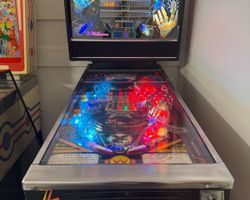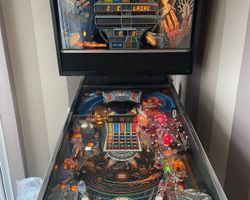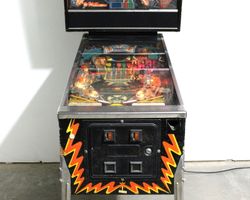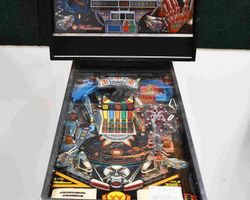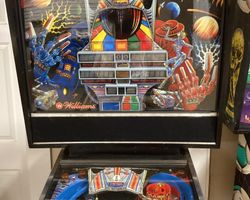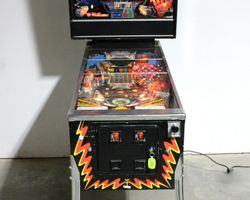PIN·BOT
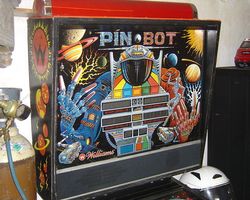
Average Prices: USD $300 to $1,700
Produced: October, 1986
Production Run: 12,001 units
Machine Type: Solid State Electronic
MPU: Williams System 11A
Players: 4
Concept by: Python Anghelo
Design by: Barry Oursler, Python Anghelo
Art by: Python Anghelo
Mechanics by: Joe Joos Jr.
Music by: Chris Granner
Sound by: Chris Granner, Bill Parod
Software by: Bill Pfutzenreuter
Williams Electronic Games introduced "PINBOT" to the market in October 1986, signaling an evolution in pinball machine design and player engagement. This machine emerged during a pivotal period for Williams, as it further developed its System 11 platform, which brought enhanced sound, speech, and display capabilities compared to earlier systems. With a significant production run of 12,001 units, PINBOT quickly established itself as a commercial success and a prominent title of its era.
The machine's central theme revolves around a futuristic, benevolent robot, set against a backdrop of cosmic imagery and space exploration. The concept and execution of PINBOT were largely driven by the creative synergy of its design team. The game's primary design was a collaboration between Barry Oursler and Python Anghelo, with Anghelo also responsible for the distinctive artwork that defines the machine's aesthetic. Chris Granner and Bill Parod crafted the soundscape, featuring dynamic music and effects, while Bill Pfutzenreuter handled the software development. Barry Oursler lent his voice to the machine's custom callouts, directly engaging players with the game's titular character. The mechanical engineering was managed by Joe Joos Jr., ensuring the playfield elements functioned as intended. This collective effort produced a game that was not only visually and audibly striking but also mechanically innovative, positioning PINBOT as a key release in the burgeoning System 11 lineup. Its release marked a step forward in how pinball machines could tell a story and immerse players through integrated audio-visual elements and interactive playfield toys.
Distinctive Design Elements
PINBOT's design is characterized by several standout features that collectively define its identity and enhance the gameplay experience. Foremost among these is the sculpted robot head prominently positioned on the upper-center playfield. This isn't merely a static decorative element; it is an interactive toy. The robot's visor can open and close, revealing a bank of "eyes"—illuminated targets that are central to the game's progression. This animated mechanism provides a tangible visual and mechanical reward for precise shots, signaling key achievements within the game.
Python Anghelo's artwork further distinguishes PINBOT. His signature style is immediately recognizable, featuring bold, vibrant colors, geometric patterns, and a fusion of robotic and cosmic motifs. The backglass depicts the benevolent robot in a star-filled void, beckoning players into its mechanical world. This aesthetic extends to the cabinet art and the playfield itself, where the rich blues, purples, and reds create an otherworldly atmosphere that perfectly complements the sci-fi theme. The cohesive visual design, combined with Chris Granner's thematic musical score and Barry Oursler's custom callouts from the PINBOT character, creates a cohesive and immersive experience. The machine communicates directly with the player, guiding them through objectives and celebrating their successes with a distinct robotic voice, which was an advanced feature for its time.
Playfield Layout and Mechanics
The playfield of PINBOT is thoughtfully designed to encourage specific shot-making while offering a balance of controlled play and chaotic action. Dominating the upper-center is the PINBOT head, surrounded by various targets and lanes. Below the head are three drop targets that spell out "PIN." Completing this bank often initiates a bonus or prepares other features.
A single, sweeping ramp on the left side of the playfield serves as a crucial shot for progression and scoring. Successful ramp shots often contribute to the game's solar value progression. The upper playfield also features three pop bumpers, strategically placed to create random, high-energy ball movement and provide additional scoring opportunities. These bumpers keep the ball in play in the upper areas, prolonging excitement.
The overall flow of the playfield encourages players to repeatedly shoot the targets on the PINBOT head to "light the eyes." Once the eyes are illuminated, a shot through a scoop located within the head's open visor initiates the two-ball multiball, a primary scoring opportunity. The lower playfield consists of two standard flippers and various return lanes and rollovers that guide the ball back to the flippers or to the top of the playfield for another run. The layout, while appearing straightforward, demands both accuracy to hit the specific targets on the robot's face and strategic awareness to manage ball control and exploit scoring opportunities. The artwork on the playfield integrates seamlessly with the mechanical elements, with pathways and targets illuminated to guide the player's focus and highlight objectives. The lighting system emphasizes the interactive elements, making the progression through the game visually apparent and satisfying.
Engaging Gameplay Dynamics
PINBOT's gameplay mechanics are centered around a clear, progressive objective: to "light the PINBOT's eyes" and traverse the solar system. The game begins with a dark visor on the robot's head. Players must hit a series of targets on the head to light up the robot's "eyes." Each lit eye contributes to the overall goal. Once all eyes are lit, the visor opens, revealing a shot or a scoop behind it. Making this shot initiates a two-ball multiball, a frantic period of high scoring where players aim to hit flashing targets for maximum points.
Beyond the multiball, a core gameplay element involves collecting "solar values." As players make specific shots, often the ramp or certain orbits, they advance through a sequence of planets in the solar system (Sun, Mercury, Venus, Earth, Mars, Jupiter, Saturn, Uranus, Neptune, Pluto). Each collected planet increases a cumulative bonus value, with Pluto representing the highest possible achievement. The game encourages players to manage their shots to achieve multiball and then systematically collect solar values to maximize their score.
Player strategies often revolve around consistent shooting of the PINBOT head to activate multiball, then precise shots during multiball to capitalize on high-value targets. Skilled players also focus on chaining shots to advance through the solar system quickly, understanding that reaching the higher-value planets is crucial for competitive scores. The combination of direct objectives, escalating rewards, and the urgency of multiball makes PINBOT a captivating experience that rewards both accuracy and strategic planning.
Enduring Reception and Legacy
PINBOT has garnered a positive reception within the pinball community since its release and holds a respectable place in pinball history. Its strengths are frequently highlighted by players and collectors alike. The interactive PINBOT head is universally praised as a compelling playfield toy and a unique central mechanic that sets the game apart. The custom speech, particularly the distinctive robotic voice of PINBOT, is often cited as a highlight, contributing significantly to the game's personality and immersion. Chris Granner's musical compositions and Python Anghelo's vibrant artwork are also consistently lauded for creating a strong, cohesive sci-fi atmosphere that remains appealing. The game’s fast-paced flow and accessible ruleset make it enjoyable for both casual players and experienced enthusiasts, offering a satisfying blend of precision shots and chaotic pop bumper action. The solid production number of 12,001 units is a testament to its commercial success and broad appeal during its initial release.
While generally well-regarded, some feedback points to the potential for shot repetition, as the core strategy often revolves around repeatedly lighting the eyes and collecting solar values. Compared to later System 11 games that introduced deeper rulesets and more complex objectives, PINBOT’s progression might be considered simpler by some modern players. However, this simplicity can also be seen as a strength, offering a clear and engaging experience without overwhelming new players. Like any machine with complex mechanisms, the visor assembly on the PINBOT head can require maintenance over time, a common consideration for collectors.
PINBOT's legacy is significant, particularly its role in establishing a thematic trilogy. Its success directly led to the development of "Jack-Bot" and "The Machine: Bride of Pinbot," each building upon the original concept and evolving the narrative of the sentient robot. This continuation solidified PINBOT's place as the foundational entry in a memorable series. Furthermore, as an early title on the Williams System 11 platform, PINBOT showcased the capabilities of the new technology, demonstrating how advanced sound, speech, and display features could enhance gameplay and theme integration. Its commercial success contributed to the widespread adoption and subsequent development of the System 11 platform, paving the way for many beloved Williams titles that followed. Today, PINBOT remains a sought-after machine for collectors, valued for its unique theme, engaging gameplay, and its undeniable historical significance within the pinball canon as a representative of a transformative era in pinball design.
Sponsored Links
 Ebay Listings
Ebay Listings
 Auction Results
Auction Results
| Cost | Location | Date |
|---|---|---|
| USD $1,500 |  Pennsylvania, United States Pennsylvania, United States |
19 September, 2025 |
| USD $2,600 |  Ohio, United States Ohio, United States |
19 August, 2025 |
| USD $5,500 |  California, United States California, United States |
25 July, 2025 |
| GBP £1,250 |  Havant, United Kingdom Havant, United Kingdom |
01 June, 2025 |
| USD $3,100 |  North Carolina, United States North Carolina, United States |
15 March, 2025 |
| USD $3,250 |  Pennsylvania, United States Pennsylvania, United States |
13 March, 2025 |
| USD $3,200 |  Texas, United States Texas, United States |
22 December, 2024 |
| USD $1,400 |  Maryland, United States Maryland, United States |
12 December, 2024 |
| USD $2,500 |  Arizona, United States Arizona, United States |
26 November, 2024 |
| USD $3,255 |  Georgia, United States Georgia, United States |
11 November, 2024 |


Private Policy · Search Website · Contact Us
As an eBay Partner, we may earn a commission from qualifying purchases made through links on this site, at no additional cost to you.
All trademarks and copyrighted materials remain property of their respective owners. All other content copyright 2007 - 2025 Pinpedia.

